
Coin collecting is the collecting of coins or other forms of minted legal tender. Coins of interest to collectors include beautiful, rare, and historically significant pieces. Collectors may be interested, for example, in complete sets of a particular design or denomination, coins that were in circulation for only a brief time, or coins with errors. Coin collecting can be differentiated from numismatics, in that the latter is the systematic study of currency as a whole, though the two disciplines are closely interlinked.

1943 steel cents are U.S. one-cent coins that were struck in steel due to wartime shortages of copper. The Philadelphia, Denver, and San Francisco mints each produced these 1943 Lincoln cents. The unique composition of the coin has led to various nicknames, such as wartime cent, steel war penny, zinc cent and steelie. The 1943 steel cent features the same Victor David Brenner design for the Lincoln cent which had been in use since 1909.
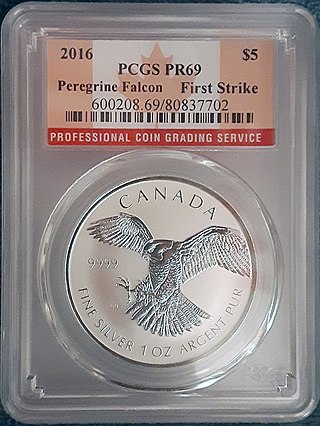
Coin grading is the process of determining the grade or condition of a coin, one of the key factors in determining its collectible value. A coin's grade is generally determined by six criteria: strike, preservation, luster, color, attractiveness, and occasionally the country/state in which it was minted. Several grading systems have been developed. Certification services professionally grade coins for tiered fees.

The Eisenhower dollar is a one-dollar coin issued by the United States Mint from 1971 to 1978; it was the first coin of that denomination issued by the Mint since the Peace dollar series ended in 1935. The coin depicts President Dwight D. Eisenhower on the obverse, and a stylized image honoring the 1969 Apollo 11 Moon mission on the reverse. Both sides were designed by Frank Gasparro, with the reverse based on the mission patch designed by astronaut Michael Collins. It is the only large-size U.S. dollar coin whose circulation strikes contained no silver.

The quarter, short for quarter dollar, is a Canadian coin worth 25 cents or one-fourth of a Canadian dollar. It is a small, circular coin of silver colour. According to the Royal Canadian Mint, the official name for the coin is the 25-cent piece, but in practice it is usually called a "quarter", much like its American counterpart. In Canadian French, it is called a caribou or trente sous. The coin is produced at the Royal Canadian Mint's facility in Winnipeg, Manitoba.

The Canadian fifty-cent coin is a Canadian coin worth 50 cents. The coin's reverse depicts the coat of arms of Canada. At the opening ceremonies for the Ottawa branch of the Royal Mint, held on January 2, 1908, Governor General Earl Grey struck the Dominion of Canada's first domestically produced coin. It was a silver fifty-cent coin bearing the effigy of King Edward VII.

The American Silver Eagle is the official silver bullion coin of the United States.
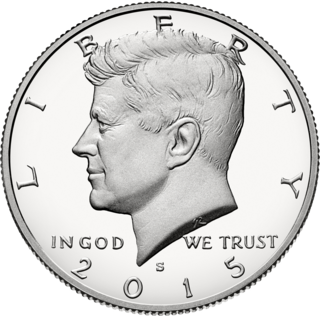
The Kennedy half dollar, first minted in 1964, is a fifty-cent coin issued by the United States Mint. Intended as a memorial to the assassinated 35th president of the United States John F. Kennedy, it was authorized by Congress just over a month after his death. Use of existing works by Mint sculptors Gilroy Roberts and Frank Gasparro allowed dies to be prepared quickly, and striking of the new coins began in January 1964.

Numismatic Guaranty Company (NGC) is an international third-party coin grading and certification service based in Sarasota, Florida. It has certified more than 60 million coins. NGC certification consists of authentication, grading, attribution, and encapsulation in clear plastic holders. NGC is a subsidiary of Certified Collectibles Group (CCG), which owns six collectible certification services and is in turn owned by Blackstone, a multibillion-dollar New York City hedge fund.

The San Francisco Mint is a branch of the United States Mint. Opened in 1854 to serve the gold mines of the California Gold Rush, in twenty years its operations exceeded the capacity of the first building. It moved into a new one in 1874, now known as the Old San Francisco Mint. In 1937 Mint operations moved into a third building, the current one, completed that year.
This glossary of numismatics is a list of definitions of terms and concepts relevant to numismatics and coin collecting, as well as sub-fields and related disciplines, with concise explanations for the beginner or professional.
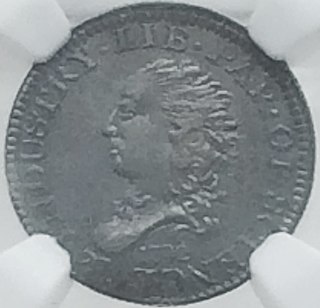
The 1792 half disme is an American silver coin with a face value of five cents which was minted in 1792. Although it is subject to debate as to whether this was intended to be circulating coinage or instead an experimental issue, President George Washington referred to it as "a small beginning" and many of the coins eventually were released into circulation. It is widely considered the first United States coinage struck under authority of the Coinage Act of 1792.
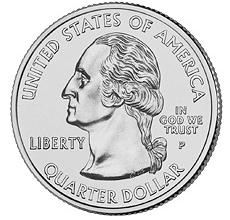
The term uncirculated coin can refer to three things:
Third-party grading (TPG) refers to coin grading & banknote grading authentication, attribution, and encapsulation by independent certification services.
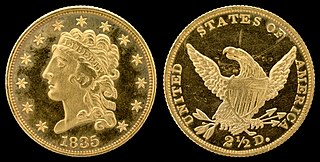
The Classic Head $2.50 gold coin is an American coin, also called a quarter eagle, minted from 1834 to 1839. It features Liberty on the obverse and an eagle on the reverse.
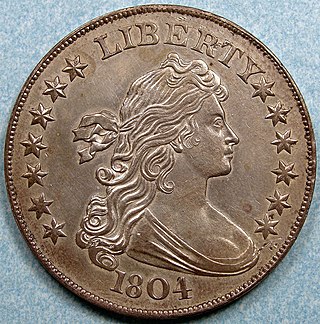
The 1804 dollar or Bowed Liberty Dollar was a dollar coin struck by the United States Mint, of which fifteen specimens are currently known to exist. Though dated 1804, none were struck in that year; all were minted in the 1830s or later. They were first created for use in special proof coin sets used as diplomatic gifts during Edmund Roberts' trips to Siam and Muscat.
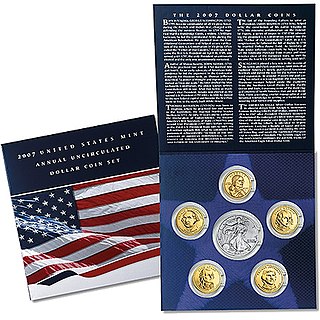
A coin set, or mint set, is a collection of uncirculated or proof coins, released by a mint. Such sets are usually released annually and often called a year set. They include sets of all the circulating coins of that year, as well as sets of commemorative coins.

Coin cleaning is the controversial process of removing undesirable substances from a coin's surface in order to make it more attractive to potential buyers. The subject is disputed among the numismatic community whether cleaning coins is necessary. Those that argue in favor of cleaning are also in dispute on which methods work best. It was once common practice to clean coins as the method was recommended by experts in the field. Solutions from pencil erasers to wire brushes and potassium cyanide were all used as cleaning agents with the goal to make the coin look brilliant again. When certified grading came into use in the mid 1980s though, the practice of cleaning coins diminished over time. Most coin experts have since come out against cleaning coins, as doing so can negatively affect them both in grade and value. If a potentially valuable coin must be cleaned then professional work is recommended. Commonly found coins are mentioned as ideal candidates for any attempted cleaning experiments.
The United States Uncirculated Coin Set, known as the Uncirculated Set or Mint Set in the United States, is an annual coin set sold by the United States Mint. The set is marketed towards coin collectors as a way to obtain circulation coins in mint condition.

The 1893-S Morgan dollar is a United States dollar coin struck in 1893 at the San Francisco Mint. It is the lowest mintage business strike Morgan dollar in the series. The 1893-S is considered to be a key date in the Morgan dollar series: examples of the coin in both mint state and in circulated condition are valuable.
![Example of an Early American Cent - the coins that inspired Sheldon to create a more precise grading scale. (Courtesy of the National Numismatic Collection, National Museum of American History [photograph by Jaclyn Nash].) NNC-US-1793-1C-Flowing Hair Cent (chain).jpg](http://upload.wikimedia.org/wikipedia/commons/thumb/e/e8/NNC-US-1793-1C-Flowing_Hair_Cent_%28chain%29.jpg/440px-NNC-US-1793-1C-Flowing_Hair_Cent_%28chain%29.jpg)

















